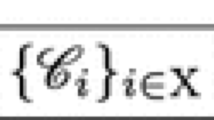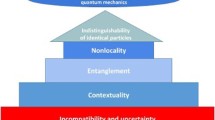Abstract
We present an information-theoretic interpretation of quantum formalism based on a Bayesian framework and devoid of any extra axiom or principle. Quantum information is construed as a technique for analyzing a logical system subject to classical constraints, based on a question-and-answer procedure. The problem is posed from a particular batch of queries while the constraints are represented by the truth table of a set of Boolean functions. The Bayesian inference technique consists in assigning a probability distribution within a real-valued probability space to the joint set of queries in order to satisfy the constraints. The initial query batch is not unique and alternative batches can be considered at will. They are enabled mechanically from the initial batch, quite simply by transcribing the probability space into an auxiliary Hilbert space. It turns out that this sole procedure leads to exactly rediscover the standard quantum information theory and thus provides an information-theoretic rationale to its technical rules. In this framework, the great challenges of quantum mechanics become simple platitudes: Why is the theory probabilistic? Why is the theory linear? Where does the Hilbert space come from? In addition, most of the paradoxes, such as uncertainty principle, entanglement, contextuality, nonsignaling correlation, measurement problem, etc., become straightforward features. In the end, our major conclusion is that quantum information is nothing but classical information processed by a mature form of Bayesian inference technique and, as such, consubstantial with Aristotelian logic.

Similar content being viewed by others
References
Shannon, C. E.: A mathematical theory of communication, Bell System Technical Journal, 27 379–423 , 656–715. (1948), http://pespmc1.vub.ac.be/books/Shannon-TheoryComm.pdf
Szilard, L.: On the Decrease of Entropy in a Thermodynamic System by the Intervention of Intelligent Beings, Zeitschrift fuer Physik, 53 840–856, (1929). http://sns.ias.edu/~tlusty/courses/InfoInBioParis/Papers/Szilard1929.pdf
Brillouin, L.: Science and Information Theory, Academic Press, New-York, (1956). http://www.physics.mcgill.ca/~delrio/courses/phys559/lectures%20and%20notes/Brillouin-Information-Theory-Ch1-4.pdf
Wheeler, J.A.: Information, physics, quantum: the search for links. In: Zurek, W. (ed.) Complexity, entropy, and the physics of information, pp. 3–28. Addison-Wesley, Redwood City (1990)
Landauer, R.: The physical nature of information, Physics Letters A, 217 188–193, (1996). http://cqi.inf.usi.ch/qic/64_Landauer_The_physical_nature_of_information.pdf
Jaynes, E. T.: Probability Theory: the logic of science, Cambridge University Press, Cambridge, UK, (2003). http://omega.math.albany.edu:8008/JaynesBook.html
Jaynes, E. T.: Clearing up mysteries, in: J. Skilling (Ed.), Maximum entropy and Baysian methods, Kluwer, Dordrecht, (1989), pp. 1–29. http://bayes.wustl.edu/etj/articles/cmystery.pdf
Rovelli, C.: Relational quantum mechanics. Int. J. Theor. Phys. 35, 1637–1678 (1996). https://doi.org/10.1007/BF02302261
Caves, C.M., Fuchs, C.A., Schack, R.: Quantum probabilities as Bayesian probabilities. Phys. Rev. A 65(2), 22305 (2002). arXiv:quant-ph/0106133
Mermin, N. D.: Qbism puts the scientist back into science, Nature, 507 421–422, (2014). http://www.nature.com/polopoly_fs/1.14912!/menu/main/topColumns/topLeftColumn/pdf/507421a.pdf
Fuchs, C. A.: QBism, The Perimeter of Quantum Bayesianism (2010). arXiv:1003.5209
Boyd, S., Vandenberghe, L.: Convex optimization, Cambridge University Press, Cambridge, (2004). http://www.stanford.edu/~boyd/cvxbook/bv_cvxbook.pdf
Cox, R. T.: Probability, frequency, and reasonable expectation, American Journal of Physics, 14 1–13, (1946). http://jimbeck.caltech.edu/summerlectures/references/ProbabilityFrequencyReasonableExpectation.pdf
Maassen, H., Uffink, J.B.M.: Generalized entropic uncertainty relations. Phys. Rev. Lett. 60, 1103–1106 (1988)
Frank, R.L., Lieb, E.H.: Entropy and the uncertainty principle. Annales Henri Poincaré 13, 1711–1717 (2012). arXiv:1109.1209
Yeung, R.W.: Information theory and network coding. Springer-Verlag, New York (2008)
Murty, K.G.: Linear programming. Wiley, New York (1983)
Caticha, A.: Lectures on probability, entropy, and statistical physics, In: 28th International Workshop on Bayesian Inference and Maximum Entropy Methods in Science and Engineering, (2008). arXiv:0808.0012
Feldmann, M.: New loophole for the Einstein-Podolsky-Rozen paradox. Found. Phys. Lett. 8(1), 41–53 (1995). https://doi.org/10.1007/BF02187530. arXiv:quant-ph/9904051
Barrett, J., Linden, N., Massar, S., Pironio, S., Popescu, S., Roberts, D.: Nonlocal correlations as an information-theoretic resource. Phys. Rev. A 71(2), 022101 (2005). arXiv:quant-ph/0404097
Popescu, S., Rohrlich, D.: Quantum nonlocality as an axiom. Found. Phys. 24, 379 (1994). arXiv:quant-ph/9508009
Birkhoff, G., von Neumann, J.: The logic of quantum mechanics, Annals of Mathematics, 37 823, (1936). http://www.jstor.org/stable/1968621
Jaynes, E. T.: Information theory and statistical mechanics. II, Phys. Rev. 108(2) 170–190, (1957). http://bayes.wustl.edu/etj/articles/theory.2.pdf
Wigner, E. P.: Normal form of antiunitary operators, J. Math. Phys. 1(5) 409–413, (1960). https://link.springer.com/chapter/10.1007/978-3-662-02781-3_38
Durt, T., Englert, B.-G., Bengtsson, I., Zyczkowski, K.: On mutually unbiased bases. Int. J. Quantum Info. 8, 535–640 (2010). arXiv:1004.3348
Kalev, A., Gour, G.: Mutually unbiased measurements in finite dimensions, New Journal of Physics, 16(5), 053038 (2014). arXiv:1401.2706. http://stacks.iop.org/1367-2630/16/i=5/a=053038
Schwinger, J.: Unitary Operator Bases, Proc. Nat. Acad. Sci. USA. 46, 560 (1960). http://www.pubmedcentral.nih.gov/picrender.fcgi?artid=222876 &blobtype=pdf
Wiener, N.: The role of the observer, Philosophy of Science, 3(3), 307–319 (1936). http://www.jstor.org/stable/184668
Feynman, R., Weinberg, S.: Elementary particle physics and the laws of physics. Gen. Relativ. Gravitat. 33, 615–616 (1986)
Klein, F.: A comparative review of recent researches in geometry, Gesammelte mathematische Abhandlungen, 1, 460–497 (1931). arXiv:0807.3161. http://gdz.sub.uni-goettingen.de/dms/load/img/?PPN=PPN243240503 &DMDID=dmdlog45
Zuber, J.-B.: Invariances in physics and group theory, In: Conference “Lie and Klein; the Erlangen program and its impact on mathematics and physics”, Strasbourg, Sept. 2012, (2013). arXiv:1307.3970
Deutsch, D.: Quantum theory, the Church-Turing principle and the universal quantum computer, Proceedings of the Royal Society of London A: Mathematical, Physical and Engineering Sciences 400(1818), 97–117 (1985). https://people.eecs.berkeley.edu/~christos/classics/Deutsch_quantum_theory.pdf
Gray, J.: Plato’s Ghost: the modernist transformation of mathematics. Princeton University Press, Princeton (2008)
Bouleau, N.: La jonction entre la théorie du potentiel et les probabilités, Cahiers du séminaire d’histoire des mathématiques, 8, 43–66 (1987). http://www.numdam.org/article/CSHM_1987__8__43_0.pdf
Meyer, P.-A., Dellacherie, C.: Probabilité et potentiel, vol. 1 and 2, Hermann, Paris, 1975, (2008)
Hiley, B. J.: Process and the implicate order: their relevance to quantum theory and mind. https://citeseerx.ist.psu.edu/viewdoc/download?doi=10.1.1.357.4976 &rep=rep1 &type=pdf
Aerts, D., Gabora, L., Sozzo, S., Veloz, T.: Quantum structure in cognition: Fundamentals and applications, In: V. Privman, V. Ovchinnikov (Eds.), Proceedings of the Fifth International Conference on Quantum, Nano and Micro Technologies (ICQMN 2011), International Academy, Research and Industry Association, (2011), pp. 57–62. arXiv:1104.3344
Busemeyer, J.R., Bruza, P.D.: Quantum models of cognition and decision. Cambridge University Press, Cambridge (2012)
Bruza, P., Busemeyer, J., Gabora, L.: Introduction to the Special Issue on Quantum Cognition (2013). arXiv:1309.5673
Dzhafarov, E.N., Kujala, J.V.: Selectivity in probabilistic causality: where psychology runs into quantum physics. J. Math. Psychol. 56, 54–63 (2012). arXiv:1110.2388
Dzhafarov, E.N., Kujala, J.V.: Quantum entanglement and the issue of selective influences in psychology: an overview. Lecture Notes Comput. Sci. 7620, 184–195 (2012). arXiv:1209.0041
Haven, E., Khrennikov, A.: Quantum Soc. Sci. Cambridge University Press, Cambridge (2013)
Clark, S., Coecke, B., Grefenstette, E., Pulman, S., Sadrzadeh, M.: A quantum teleportation inspired algorithm produces sentence meaning from word meaning and grammatical structure (2013). arXiv:1305.0556
Ionicioiu, R.: Quantum mechanics: Knocking at the gates of mathematical foundations, In: I. Parvu, G. Sandu, I. Toader (Eds.), Romanian Studies in Philosophy of Science, Vol. 313 of Boston Studies in the Philosophy and History of Science, Springer, (2015). arXiv:1506.04511
Einstein, A., Born, M.: The Born-Einstein letters. Walker and Company, New-York (1971)
Feynman, R.: Lessons on Probability and Uncertainty in quantum mechanics, Cornell Messenger Lecture Archive, (2011)
Fuchs, C.A.: Quantum mechanics as quantum information (and only a little more). In: Khrennikov, A. (ed.) Quantum Theory: Reconsideration of Foundations, pp. 463–543. Växjö University Press, Växjö, Sweden (2002) . arXiv:quant-ph/0205039
Articles, In: J. T. Cushing, A. Fine, S. Goldstein (Eds.), Bohmian Mechanics and Quantum Theory: An Appraisal, Kluwer, Dordrecht, (1996)
Griffiths, R.B., Omnès, R.: Consistent histories and quantum measurements. Phys. Today 52(8), 26–31 (1999)
Cramer, J.G.: An overview of the transactional interpretation of quantum mechanics. Int. J. Theor. Phys. 27, 227–236 (1988)
Ghirardi, G. C., Pearle, P.: Dynamical reduction theories: Changing quantum theory so the statevector represents reality, In: M. F. A. Fine, L. Wessels (Eds.), Proceedings of the Biennial Meeting of the Philosophy of Science Association, Philosophy of Science Association, East Lansing, MI, (1990)
Zurek, W.H.: Decoherence, Einselection and the existential interpretation (The Rough Guide). Phil. Trans. R. Soc. Lond. A 356, 1793–1821 (1998). arXiv:quant-ph/9805065
Grangier, P.: Contextual objectivity: a realistic interpretation of quantum mechanics (2000). arXiv:quant-ph/0012122
Deutsch, D.: The fabric of reality: the science of parallel universes and its implications. Allen Lane, New York (1997)
Vaidman, L.: The many-worlds interpretation of quantum mechanics, In: E. N. Zalta (Ed.), The Stanford Encyclopedia of Philosophy, Stanford University, Stanford, CA, (2002). http://plato.stanford.edu/entries/qm-manyworlds/
Spekkens, R.W.: Contextuality for preparations, transformations, and unsharp measurements. Phys. Rev. A 71, 052108 (2005). arXiv:quant-ph/0406166
Chiribella, G., D’Ariano, G.M., Perinotti, P.: Informational derivation of quantum theory. Phys. Rev. A 84(1), 012311 (2011). arXiv:1011.6451
Hardy, L.: Reconstructing quantum theory (2013). arXiv:1303.1538
Moeller, M. P., Masanes, L.: Information-theoretic postulates for quantum theory (2012). arXiv:1203.4516
Masanes, L., Mueller, M.P., Augusiak, R., Perez-Garcia, D.: A digital approach to quantum theory. Proc. Nat. Acad. Sci. USA 110(41), 16373 (2013). arXiv:1208.0493
Chiribella, G., D’Ariano, G. M., Perinotti, P.: Quantum from principles, In: R. Spekkens, G. Chiribella (Eds.), Quantum theory: informational foundations and foils, Springer Verlag, in press. arXiv:1506.00398
Oeckl, R.: A local and operational framework for the foundations of physics. arXiv:1610.09052
Pitowsky, I.: Quantum mechanics as a theory of probability (2005). arXiv:quant-ph/0510095
Janotta, P., Hinrichsen, H.: Generalized probability theories: what determines the structure of quantum theory? J. Phys. A Math. General 47(32), 323001 (2014). arXiv:1402.6562
Pawłowski, M., Paterek, T., Kaszlikowski, D., Scarani, V., Winter, A., Żukowski, M.: Information causality as a physical principle. Nature 461(7267), 1101–1104 (2009)
Barnum, H., Barrett, J., Clark, L.O., Leifer, M., Spekkens, R., Stepanik, N., Wilce, A., Wilke, R.: Entropy and information causality in general probabilistic theories. N. J. Phys. 12, 033024 (2010). arXiv:0909.5075
Caticha, A.: Entropic dynamics: mechanics without mechanism (2017). arXiv:1704.02663
Fuchs, C. A., Schack, R.: Quantum-Bayesian Coherence: The No-Nonsense Version (2013). arXiv:1301.3274
Leifer, M. S., Spekkens, R. W.: Formulating Quantum Theory as a Causally Neutral Theory of Bayesian Inference (2011). arXiv:1107.5849
De Raedt, H., Katsnelson, M. I., Michielsen, K.: Quantum theory as the most robust description of reproducible experiments (2013). arXiv:1303.4574
Fuchs, C.A., Mermin, N.D., Schack, R.: An introduction to QBism with an application to the locality of quantum mechanics. Am. J. Phys. 82, 749–754 (2014). arXiv:1311.5253
Author information
Authors and Affiliations
Corresponding author
Additional information
Publisher's Note
Springer Nature remains neutral with regard to jurisdictional claims in published maps and institutional affiliations.
Rights and permissions
Springer Nature or its licensor (e.g. a society or other partner) holds exclusive rights to this article under a publishing agreement with the author(s) or other rightsholder(s); author self-archiving of the accepted manuscript version of this article is solely governed by the terms of such publishing agreement and applicable law.
About this article
Cite this article
Feldmann, M. Information-Theoretic Interpretation of Quantum Formalism. Found Phys 53, 58 (2023). https://doi.org/10.1007/s10701-023-00690-1
Received:
Accepted:
Published:
DOI: https://doi.org/10.1007/s10701-023-00690-1




